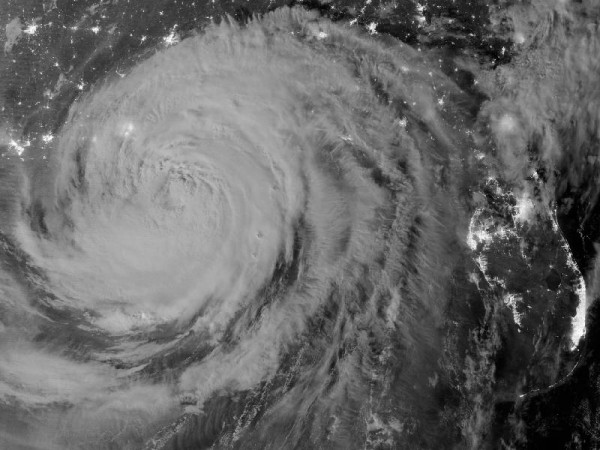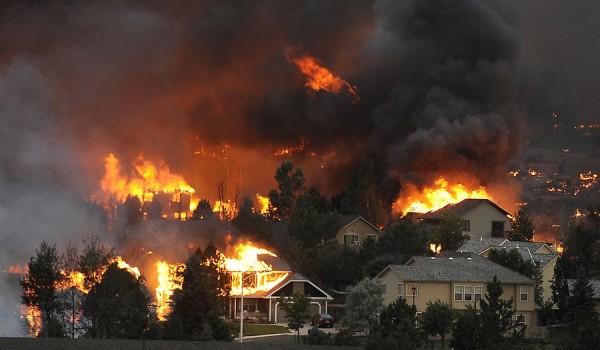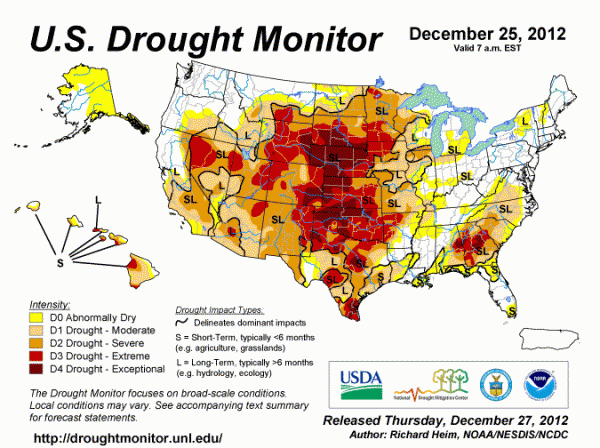According to NOAA, 2012 brought the United States 11 billion-dollar extreme weather and climate events. Seven of these events were triggered by severe weather and tornadoes, two were hurricane-related, and the other two disasters were brought upon extreme drought across the United States. Out of all of the U.S. disasters, Superstorm Sandy will become one of the costliest ever to occur within U.S. borders. All of the numbers in this post are preliminary, and they will likely change as we enter the new year and continue to receive more information and better estimates. However, the National Climatic Data Center (NCDC) is already estimating that 2012 will surpass 2011 ($60.6 billion, CPI-adjusted to 2012 dollars) in terms of aggregate costs for billion-dollar disasters in a single year.
This list of U.S. climate and weather disasters is presented here in chronological order.
1) Southeast/Ohio Valley Tornadoes — March 2–3, 2012

The most violent and deadliest tornado outbreak of 2012 occurred in early March as a strong area of low pressure evolved across the eastern United States. At least 75 tornadoes were confirmed across the states of Alabama, Georgia, Tennessee, Kentucky, Indiana, Illinois, and Ohio. This deadly outbreak caused the deaths of 42 people. The event is estimated to cost around $4 billion in damages. This outbreak was unusual in that it occurred so early in the year. Severe weather outbreaks do typically occur in the deep South in early March. However, the Midwest and Ohio River Valley were also included in the March 2012 severe weather outbreak, which meant extremely warm temperatures and higher dew points pushed that far north in latitude in March 2012.
2) Texas Tornadoes – April 2-3, 2012
3) Great Plains Tornadoes — April 13–14, 2012

The third billion-dollar disaster of 2012 occurred in the Great Plains with a large tornado outbreak. The Storm Prediction Center saw this extreme weather event days in advance, and issued a rare high-risk area warning across the Great Plains, including Kansas, Oklahoma, Nebraska and Iowa. The April 13-14 outbreak produced 98 confirmed tornadoes and included many tornadoes that remained on the ground for an extended time and traveled tens of miles. This outbreak killed six people, with the majority of those people dying in Woodward, Oklahoma. This disaster is responsible for nearly $2 billion in damages.
4) Midwest/Ohio Valley Severe Weather — April 28–May 1, 2012
5) Southern Plains/Midwest/Northeast Severe Weather — May 25–30, 2012
6) Rockies/Southwest Severe Weather — June 6–12, 2012
7) U.S. Great Plains/East/Northeast Severe Weather (“Derecho”) — June 29–July 2, 2012

This was the event that made the term “derecho” famous in 2012. A derecho is a violent storm system that can produce widespread wind damage across a large area and is associated with a band of rapidly moving showers and thunderstorms. In late June 2012, a derecho pushed through parts of Indiana, Ohio, West Virginia, Virginia, the District of Columbia, Maryland and parts of New Jersey. This storm brought widespread wind damage that left millions of people without power. For many places, it took over a week to restore power. These severe storms left 28 people dead. As of now, damages are estimated to fall around $4 billion from this one event.
8) Hurricane Isaac — August 26–31, 2012

Hurricane Isaac, the 9th named storm and 4th hurricane of the 2012 Atlantic hurricane season, caused plenty of problems across portions of Hispaniola and the United States during the last week of August. Isaac was a potent rainmaker, and resulted in flooding across the U.S. Southeast as it pushed into Louisiana and then pushed northward into Arkansas and Tennessee. Isaac was a large Category 1 storm that moved very slowly, resulting in a large storm surge and flash flooding. Severe damage was reported in parts of Louisiana, Mississippi, Alabama, and Florida. Isaac killed nearly 40 people and is estimated to have cost $2 to $3 billion in damages.
9) Western Wildfires — Summer–Fall, 2012

The number and large coverage of wildfires across the western U.S. became one of the biggest weather and climate stories of 2012. Wildfires burned over 9.1 million acres across the U.S. in 2012. This is the 2nd-highest annual total since the year 2000, only exceeded by 2006 when 9.4 million acres burned. Some of the most damaging wildfires occurred in western states including Colorado, Idaho, Wyoming, Montana, California, Nevada, Oregon, and Washington. Perhaps the biggest 2012 wildfire story occurred in Colorado, particularly around the city of Colorado Springs, which experienced the most costly wildfires (e.g., Waldo Canyon fire) in which several hundred residences were destroyed. According to the NCDC, eight people died due to the wildfires that broke out across the U.S. Estimated costs for the wildfires is around $1 to $2 billion.
10) Hurricane Sandy — October 29–31 2012

On any list of 2012 weather and climate disasters in the United States, Hurricane Sandy naturally ranks near the top. This storm devastated parts of the U.S. Northeast in late October 2012. Extensive damage across several states in the U.S. Northeast that included Maryland, Delaware, New Jersey, New York, Connecticut, Maine, and Rhode Island due to high wind and coastal storm surge. Sandy made landfall near the southern portion of New Jersey on October 29, 2012 and transitioned from a hurricane, or warm-core system, to an extratropical cyclone, or cold-core system. Sandy was an extremely large storm that had tropical storm force winds (39 mph to 73 mph) that expanded over an area of 943 miles. Not only did it affect the U.S. Northeast, but Sandy also affected the entire U.S. East Coast. It came with strong winds and cold temperatures in the U.S. Southeast, and heavy snow and blizzard conditions in West Virginia. Sandy’s impact on major population centers such as New York City caused widespread interruption to critical water / electrical services and also caused 131 deaths. Sandy also caused the New York Stock Exchange to close for two consecutive business days, which last happened in 1888 due to a major winter storm. Sandy will likely be ranked as the second-costliest natural disaster ever to hit the United States, right behind 2005’s Hurricane Katrina ($108 billion dollars in damage that killed 1,833 people). Estimated costs for Sandy are currently over $62 billion, and this number could go up.
11) U.S. Drought/Heatwave — throughout 2012

The ongoing drought across the United States was just as extreme – if not worse – than the drought that brought on the Dust Bowl of the 1930s. Over half the U.S. experienced drought conditions in 2012, with the hardest-hit areas including the U.S. Great Plains, across the Rocky Mountains, and across the U.S. Southeast. As of December 25, 2012, over 61% of the country is still experiencing drought conditions. Drought impacts are most costly across the central agriculture states resulting in widespread harvest failure for corn, sorghum and soybean crops, among others. The dry weather across the U.S. went hand-in-hand with record heat during this past year. In fact, 2012 will go down as the warmest year ever recorded in the United States since record keeping began in 1895. The drought conditions are responsible for killing 123 people, mainly due to the extreme heat during the summer months. Triple-digit heat was very common across the country in late June and throughout July 2012. According to Jeff Masters of Weather Underground, drought upstream of the Lower Mississippi River caused record and near-record low stream flows along the river in Mississippi and Louisiana, resulting in limited river transportation and commerce. The drought is still continuing, and the costs for this drought are still unknown and will likely grow over time. Estimated costs for this extreme drought will likely be above $40 billion in damages.
Bottom line: 2012 has been one of the costliest years yet, when it comes to extreme weather and climate events across the United States. Although we saw many weather and climate disasters in 2011, too, 2012 is likely to surpass 2011 in terms of aggregate costs for billion-dollar disasters in a single year, even though fewer billion-dollar disasters happened in 2012. The two largest billion-dollar disasters that occurred in the United States in 2012 were Hurricane/Superstorm Sandy and the excessive and ongoing U.S. drought. At least 349 deaths occurred from these billion-dollar disasters in the United States in 2012. All of the estimated costs are preliminary, and NOAA will have an updated list in January 2013.











